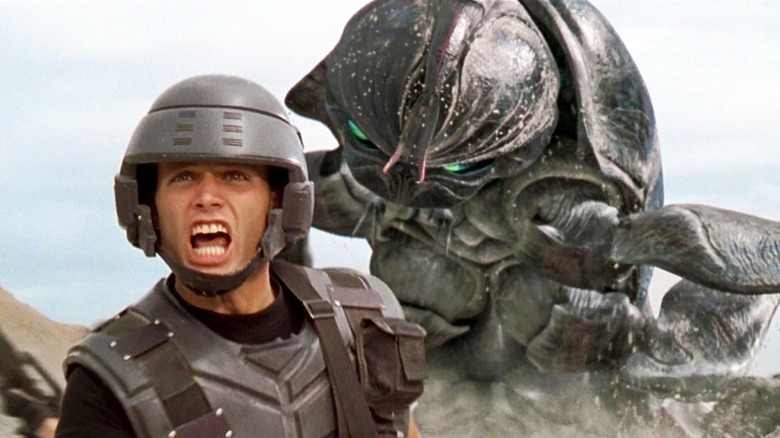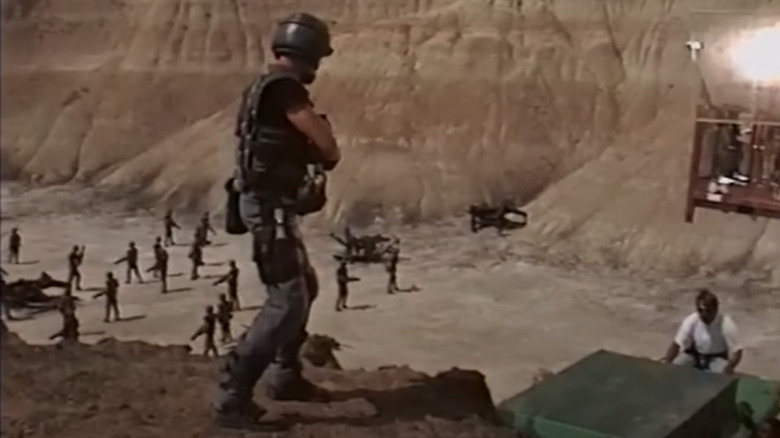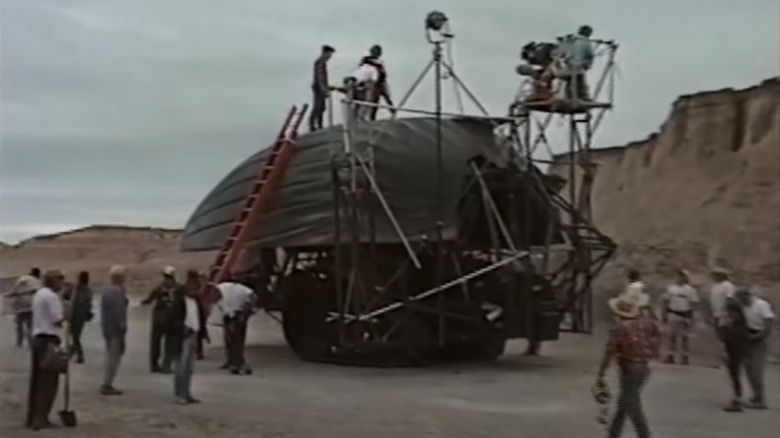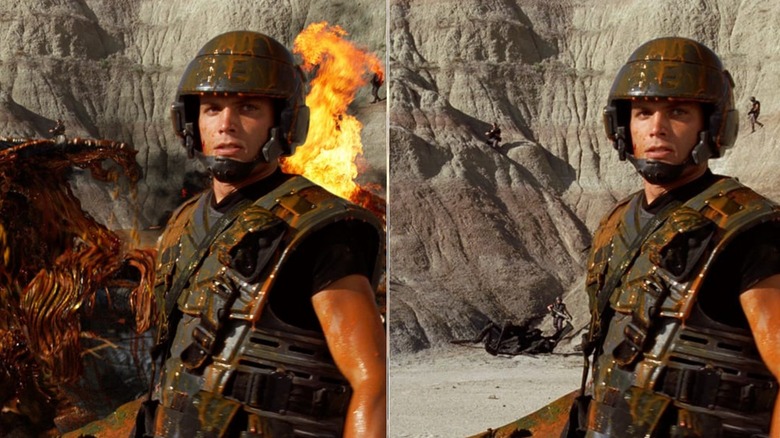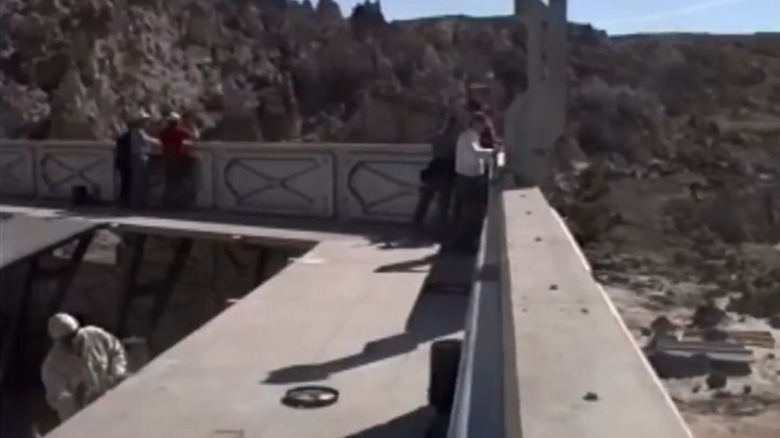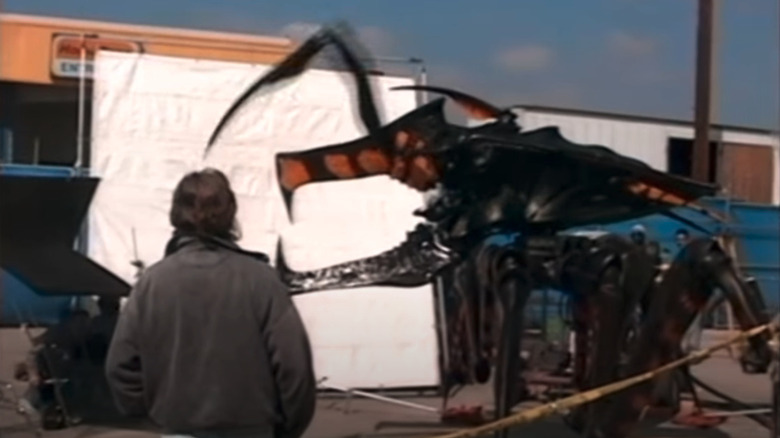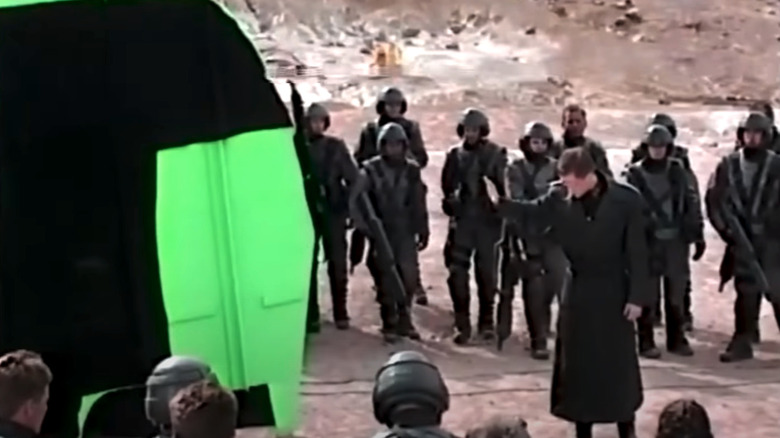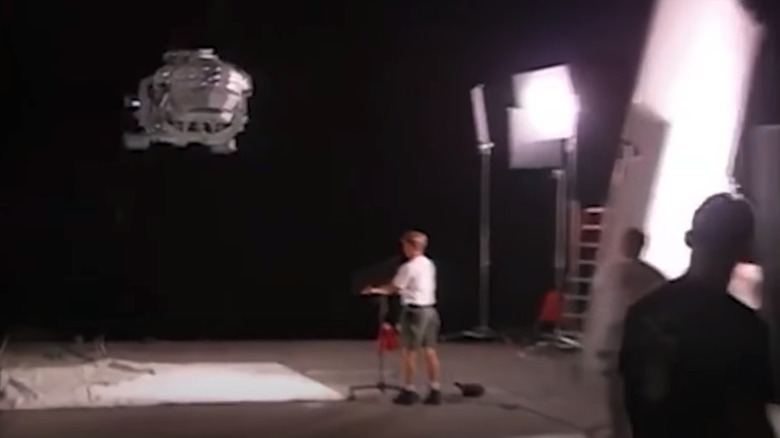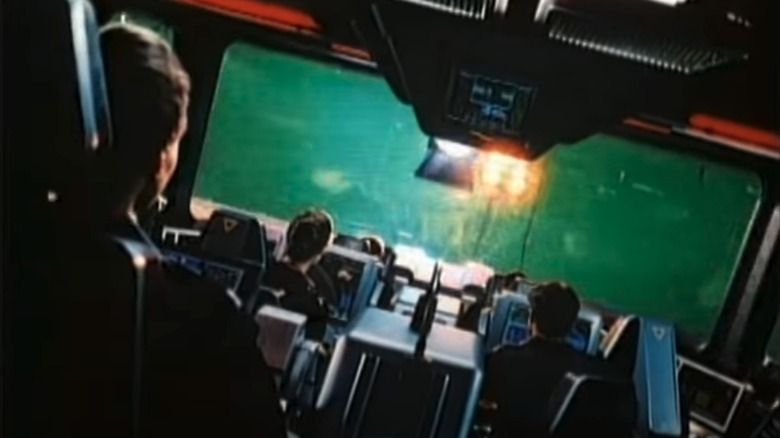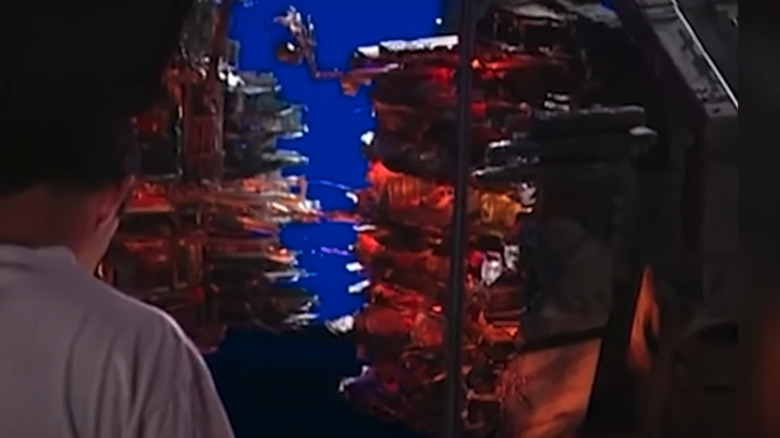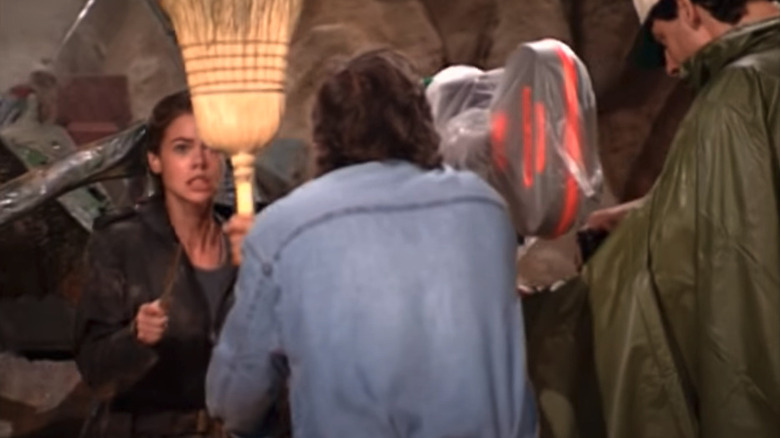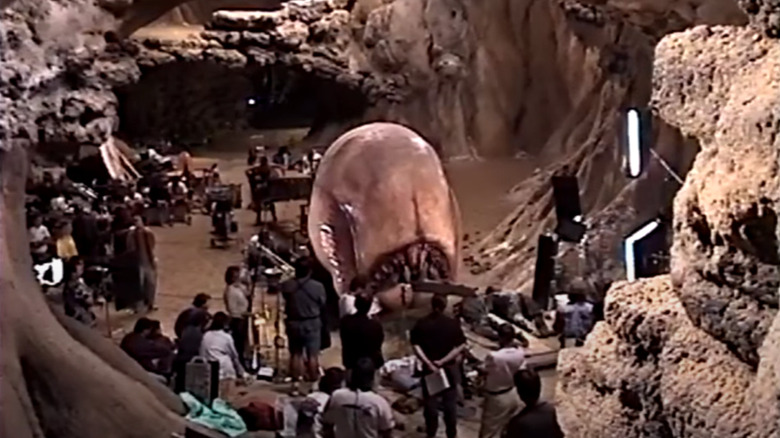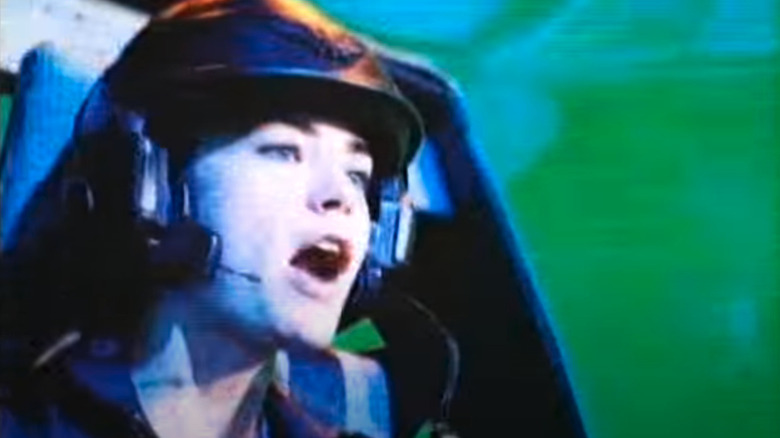What Starship Troopers Looks Like Without Special Effects
Originally a book by science fiction luminary Robert Heinlein, "Starship Troopers" tells the story of Earth's battle with a race of alien bugs. Often mistaken for overt propaganda, the film is actually a satire of military fascism and a send-up of '90s-era Western politics. But it's also a first-rate sci-fi action movie starring Casper Van Dien as Johnny Rico, a high school graduate who signs up for military service alongside his best friends Carmen Ibanez (Denise Richards), Carl Jenkins (Neil Patrick Harris), and Dizzy Flores (Dina Meyer).
Assigned to the Terran Federation's Mobile Infantry, Rico goes to the front lines when a war breaks out after a surprise attack on his hometown in Buenos Aires. Determined to strike back and wipe out the Arachnid menace once and for all, Rico is sent across the cosmos on a mission of military conquest.
While many appreciate the film for its stinging social commentary, it's hard not to enjoy the explosive action and state-of-the-art special effects that still hold up more than 25 years later. But the process of making the movie was anything but simple, with CGI still in its relative infancy in the late '90s, meaning it mixed just as much practical effects as digital. Well, if you've ever wondered what it was like behind the scenes, and what the best moments in "Starship Troopers" looked like without special effects, look no further. Because we've found some of the best scenes from the making of the movie before they were completed for the screen.
Johnny's big jump had no bugs at all
Some of the biggest, most thrilling scenes in "Starship Troopers" saw the human heroes of taking down the bugs. And one of the biggest is a moment during a pitched battle between the two forces that sees the Mobile Infantry under attack by a gigantic Tanker Bug. It's a massive insect the size of an 18-wheeler, and it seems nearly unstoppable, with gunfire doing little to even make a scratch in its armor. To finally put it down, Johnny Rico jumps atop its back by throwing himself off a ledge. Once there, he blasts a small hole in its armor and tosses in a grenade that blows it to smithereens and spills guts across the landscape.
To film this dramatic sequence required a mix of VFX both practical and computer-generated, as well as some intense on-set stunt work. The latter was achieved by having actor Casper Van Dien jump from a real rock face, landing on a green foam mat below. Later, with the use of a CGI stand-in, additional background shots of the canyon, and close-up inserts of Rico, the entire sequence was assembled to make it look like the gung-ho former high school sports star was using his fancy football moves to deadly effect. In this behind-the-scenes shot we can see Van Dien preparing for the jump, while large lighting rigs look on, and the background is noticeably missing the eventual CGI bug.
The tanker bug was mostly CGI
Casper Van Dien's big jump off the ledge was just one part of the elaborate sequence that sees him take down the Tanker Bug. Other portions of the scene required different kinds of special effects. As detailed in some behind-the-scenes footage captured by FX guru Phil Tippett, the next part of the equation involved a practical, full-scale version of the Tanker Bug for Johnny to leap onto. Of course, given that it wasn't used for the wider shots, only a portion of the bug was constructed, with just its back shell created to give the actor something to grab onto.
As seen in the footage, the rig sat atop a large apparatus capable of moving the oversized bug prop back and forth to make it seem like it was moving naturally. Cameras were then mounted on scaffolding attached to the side of the rig to capture the action, and large lighting was also stationed around the scene to get the proper look. This same construction was also used for the closeup shots that show Rico struggling to hold on as it kicks like a bucking bronco.
The shell was also recreated digitally later, and the two shots were seamlessly joined to make it appear as though Rico was riding atop a giant Tanker Bug, fighting for his life.
Johnny's victory pose uses top-notch compositing techniques
The final part of Johnny Rico's takedown of the Tanker Bug sees him jumping from its back and hiding behind the corpse of another Arachnid. As he does, the Tanker Bug explodes in a mess of guts that rains down on everything and everyone around it, including Rico. When the dust settles, he stands up proudly in a hero moment, looking back at his troops — and the audience — covered in viscera as the big bug sits broken in half and in flames behind him.
Creating just this one simple shot was nearly as complicated as the entire sequence. It included multiple camera passes and multiple effects. First, a background plate was shot of actor Casper Van Dien, standing in front of a fully practical, full-scale bug carcass prop, complete with background extras. But the bulk of the frame as you can see is left almost entirely empty because that's where another element would be added in later.
That other element is the Tanker Bug, created entirely in a computer using CGI that was cutting edge for 1997. Real fire elements were then added to make the giant bug appear to still be in flames from the explosion. Complex compositing required VFX technicians to cut out Rico's silhouette and allow the CGI bug to sit behind him, as Tippett detailed in a chat with Cartoon Brew 2017.
The Klendathu base attack was a full scale practical set
One of the first big action set pieces in "Starship Troopers" comes on the Arachnids' home planet of Klendathu, and it winds up being a botched mission and a total disaster for the Terran Federation. But to film this spectacular scene meant more than just a lot of blue screen, green screen, and CGI, but also the massive, full-scale set of a makeshift military outpost.
Videos from the making of the film show special effects supervisor Phil Tippett walking a camera around the set while it was still under construction. Interestingly, much of the compound was actually made up of pre-fabricated structures from a company called Spring Structures, which offers high-performance, modular fabric buildings, complete with furnishable interiors. These allow various industries to set up working spaces anywhere in the world quickly and efficiently, and have been used by companies like Tesla and FedEx, as well as for soundstages for TV shows "Big Love" and "The Chosen."
While narrating the tour of the encampment set, Tippett shows off various angles of the interior and the exterior of the compound where scenes take place. This includes an over-the-wall shot that showcases the desert rock terrain outside the compound walls, where a vast army of CG Arachnids will eventually be placed, and the interior wall where the giant Tanker Bug breaks through.
Some of those big bugs were actually real
In a sci-fi movie like "Starship Troopers," it's probably assumed that most of the alien critters would be computer-generated creations. That's certainly true for large portions of the film, where vast armies of CG Arachnids were created digitally to fill the scenes of attacking bugs. But the main warrior bugs also had a working, motorized, full-size robotic puppet counterpart for certain scenes, including an early sequence that shows a bug lifting a human soldier with its massive mandibles.
Designed and built by VFX icon Phil Tippett, who had previously worked on "Jurassic Park," he used a company called Amalgamated Dynamics to do the actual construction. And as Tippett told Cartoon Brew, their usage had a very specific purpose. "Most of that centered around contact, like when you actually see a real person about to be chopped in half and the beak of a bug. ... You want to keep the computer graphics people off-screen as much as possible, because they don't look so good."
Of course, as the main villain of the story, the warrior bug is the subject of plenty of behind-the-scenes footage and photos. In this still from a making-of video, the full-size practical bug robot is shown, and you can just how monstrous it really is. What you don't see in the film, of course, are the robot's many operators who control its movement.
There was no practical Brain Bug for Neil Patrick Harris' big scene
Casper Van Dien isn't the only actor in "Starship Troopers" to get to play with some big CG bugs. His co-star Neil Patrick Harris — who played military intelligence officer and powerful psychic Carl Jenkins — also got in on the fun. The mix of human and CGI happens at the end of the movie when Jenkins arrives in the aftermath of a major human victory. In a satirical twist ending, Jenkins probes the mind of the so-called "Brain Bug" and declares that "it's afraid!" while throngs of soldiers cheer.
Perhaps unsurprisingly, the oversized brainy bug was created via CGI for the scene, which has Jenkins placing his hand on the head of the bug and using his psychic powers to read its thoughts. Seen in some behind-the-scenes footage, the bug was portrayed on the set by a big green stand-in partially covered in black fabric. This temporary, jury-rigged version would be later removed in post-production and replaced with a CGI bug whose head pulsates and whose body oozes slime. What might be surprising, though, is that a full-size practical version of the Brain Bug was also created for the film, used in an earlier sequence when it attacks Carmen in a subterranean cave (but more on that later).
The Rodger Young was in an empty warehouse
As its title implies, "Starship Troopers" was about more than just soldiers, but starships as well. While there was plenty of CGI employed to bring some of them to life, many of the outer space sequences involving ships — like Carmen's cruiser called the Rodger Young — were filmed using custom-built models. One sequence involving dozens of starships under attack used models created by artisans at Sony's model shop Thunderstick, with George Lucas' Industrial Light & Magic, and a VFX studio called Boss also lending a hand.
Augmented with the use of some CG attack ships, 13 scale starships were created for the scene, which took a total of 14 months to assemble from start to finish. The scene, which saw chaos erupt when the fleet met an unexpected attack from the bugs, required the VFX team to put together all of those ships, plus background elements such as large rocks created out of foam, as well as CGI. This meant using an advanced computer software program, though even that could barely handle the task of compositing so many moving parts.
As shown in this making-of image, a single large model of the starship is dangled in front of a black backdrop to capture just one of the more than 200 individual elements, while technicians carefully arrange exterior lighting to help simulate movement. The large, empty warehouse space stands in stark contrast to the final scene: a frame buzzing with starships, explosions, and debris.
Carmen piloted through green screens
During the incredible outer space action scenes, a full-size set was built of the interior of the Rodger Young's cockpit. But for their forward view into space, which showed the horrific destruction of the Terran fleet, special digital effects were used, rather than any kind of rear projection or on-set photography. Instead, it was a standard green screen, with large lighting rigs passing back and forth to simulate the effects of explosions in front of them, casting the necessary light on the faces of the actors.
But it wasn't just the ships out the window that were CGI, but the window itself as well, as explained by Sony Imageworks' Scott E. Anderson, visual effects supervisor for the movie's spaceship sequences. "The flickering light on the windshield is actually put in in digital," he explained in a making-of featurette. "We'd create a fake glass because if you look at the glass, you see the reflections of the other ships — you see the plasma reflected in the glass, you see these scuffs on the glass."
For director Paul Verhoeven, getting the moving lights just right was like an orchestra, and crucial to making the scene convincing. As seen here, the various colored lamps are moving slowly from side to side, replaced later by scenes of massive burning ships and explosive collisions.
Massive damage to the starships was real, but the background wasn't
Amid the space battle above the bug planet Klendathu, it's not just the Rodger Young that's taking fire. Multiple massive starships are struck, splitting open and jettisoning crew into open space, crashing into each other like, as Scott E. Anderson describes, a series of slow-motion car crashes. Fiery debris from the entire fleet rains down as shuttles escape their motherships and try to stay alive in the frenzy.
Here, we see one of those wrecked vessels, which was created with elaborate model work. It's just one of many such ships built for the scene, and the presence of a VFX worker in the foreground illustrates just how large the model really is. Ultimately, the ship measured in at a whopping 18 feet and was built with removable sections to make the destruction scenes easier to shoot in stop motion later.
"We built ... our largest scale ship in two pieces," Anderson said in a making-of video. "We had the tail section which was 9 feet long [and] the head section which was 9 feet long. There were all these model movers literally who could pull the part of the ship apart. ... We also had two stop motion animators who literally frame by frame, as the ship pulled apart, bent the middle pieces of the decks, created exploding decks, collapsing decks." Photos like this one showcase how much work went into each model, with astonishing levels of detail to convince audiences that this was a massive starship cut in two by the enemy.
Denise Richards faced off against Paul Verhoeven with a broom
There are some tense moments in the finale of "Starship Troopers," and one of the most nail-biting is when Carmen is captured by the bugs. Finding herself trapped underground, where she's due to become food for them, she fails to save her new love, Zander (Patrick Muldoon), who has his head caved in and emptied out by the Brain Bug. She is, however, able to save herself by cutting the Brain Bug's piercing sucker. But if you were on the set of the film the day that scene was shot you would have seen something very different than what ended up on the screen.
Showing up in more behind-the-scenes footage is the moment where Carmen faces off against one of the bugs. But instead of a practical robotic replica, it's none other than director Paul Verhoeven she's staring down with a knife. To give her a proper eye line to look at, Verhoeven holds aloft a mighty straw broom, and in the footage, can be seen menacingly stepping forward just like the bug would, as he mimics its movement to get a proper reaction from his star actor.
Eventually, Verhoeven would leave the frame, and for shots involving the full bug, he'd be substituted for the full-size puppet of the Brain Bug, as also seen in additional making-of footage.
A massive desert set
Based on the book by Robert Heinlein, "Starship Troopers" follows the Terran Federation's war with the Arachnids across the cosmos. Battles occur on more than one world, and for some of the action, location shooting took place in South Dakota and Wyoming, but not every scene on the alien world was shot outdoors. For the film's ending scenes underground a sprawling indoor set of subterranean insect caves was created. They can be seen here in a still from a behind-the-scenes video that shows the filming of the dramatic face-off between Carmen and the practical puppet of the Brain Bug.
Surrounded by an extensive crew, including robot operators just out of the camera's view, we can see just how massive the fully realized Brain Bug is. Standing to the right of the frame is director Paul Verhoeven, who carefully choreographs the action from beneath a series of lighting rigs, while an actor — or possibly a stunt person or stand-in — lays face down before the bug on a large brown mat, preparing for a call of "action."
Carmen's shuttle escape was a shaky shot
The Rodger Young isn't the only starship piloted by Carmen. After that ship is destroyed she also gets behind the controls of an escape shuttle and is able to scoop up a number of survivors of the bug assault. As with the larger starship, a green screen is also used to make room for computer-generated images of outer space beyond the windows of the shuttle. Footage from filming the scene shows actress Denise Richards sitting in the cockpit with her headgear on, and a green screen out the window of the small vessel.
As described by director Paul Verhoeven, the crash and destruction of the Rodger Young was crafted in CGI and placed in the background of this very shot. "The foreground was shot on a gimble where you get all the trembling," the filmmaker said. The gimble is a large rig that holds the ship up in the air, with motorized controls that can shake it to and fro. These active movements help give the scene a rocky, unsteady look as Carmen pilots the shuttle away from the destruction. "The green screen was later replaced by starfields and [other] exploding ships," added Verhoeven.
